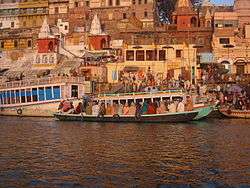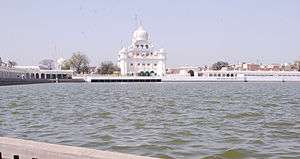Maghi

_Jaggery_Gud_Punjab_India.jpg)
Maghi is the Punjabi name for the festival of Makar Sankranti which is celebrated all over India as a winter harvest festival.[1] Maghi is celebrated on the first day of Magh as per the Punjabi calendar and is celebrated in Punjab, Himachal Pradesh and Haryana. It is a cultural, seasonal and a religious festival marking the agricultural new year, increase in daylight and holding of sports festivals.
Cultural festival
Seasonal festival
Maghi represents the increase in daylight [2] which begins to occur a day after the winter solstice and is referred to as the "bara din" (big day). The day also marks the start of the shishir season [3] as per the Punjabi calendar. The shishir season is the second half of the winter season with milder weather and accordingly, Maghi is considered to be a seasonal festival.[4] Where Maghi is celebrated in the solar month of Magh, Basant is celebrated in the corresponding lunar month of Magh. Both these festivals are seasonal with Maghi being celebrated before Basant.
Traditions
Food
Unlike other parts of India, rice is not a winter harvest in Punjab, Haryana and Himachal Pradesh.[5] However, it is harvested in autumn and its harvest is celebrated during the festival of Maghi. Accordingly, it is traditional for all Punjabis to eat rice made in boiled milk and sugarcane juice ("kheer") which is a winter produce. There is a Punjabi saying "Poh ridhi, Magh khadi" which means Kheer is boiled on the last day of the preceding Punjabi month of Poh and is eaten on the first day of the next month of Magh. In some parts of Punjab, it is also traditional to eat kichdi mixed with lentils, consume raw sugarcane and jaggery,[2] which are all winter crops. Consuming products containing sesame seeds is also traditional. Interestingly, eating saffron rice is traditional on Basant.
Moh-mahi
In some parts of Punjab, it is traditional for girls to ask for "treats" (gifts of food) from older ladies. The festival is called "moh mahi" and takes place on the morning of Maghi.[2] The only song sung on this occasion is:
moh-mahi de ke jaa - de ke ja
darhi phul puaa ke ja - pua ke ja
darhi teri hari bhari - hari bhari
phula de naal jarhi bhari - jarhi bhari
je na moh-mahi ditti su
duhatharh darhi puttu su
Translation
before you go, give me moh mahi
put flowers in your beard
your beard is blossoming
full of flowers
if you do not give me moh-mahi
I will pull your beard
(reference to the beard symbolically refers to the other lady's face).
Maghi and the New Year
The most basic method of determining a year is to consider the solstices and the spring and autumn equinox. Punjabis regard the day after winter solstice as a new year which is celebrated on Maghi.[6] Due to the way the Punjabi calendar is calculated, Maghi does not coincide with the day after the winter solstice (which occurs around 23 December) but is celebrated around 14 January.
Accordingly, Punjabi farmers see Maghi as the financial new year. Rents for agricultural tenancies commence from Maghi.[6]
Maghi Fairs
Traditionally, local fairs are held on Maghi in the region.[7][8] Various sporting events take place at the gatherings which include playing Punjabi Kabaddi, wrestling and various local sports.
Religious festival

Celebration by Hindus
Hindus visit the Mandir and bathe in rivers, especially the Holy waters of the Ganges. The month of Magh is important to give charity and meditate.[2]
Maghi is the day which represents the period of Uttarayana when the sun makes its northward journey. This actually occurs on the day after the winter solstice. However, Uttarayana commences a day after the sun ends its southward journey, a day before Maghi (Sanskrit: Dakshinayana) at the Tropic of Capricorn, (month of Poh) and starts moving northward (Sanskrit: Uttarayaana) towards the Tropic of Cancer, on the first day of Magh.
For Hindus, taking baths with sesame oil on Maghi is important as sesame is meant to wash away sins.[2]
On Maghi, Hindus also light lamps and throw sesame seeds into the flame.
Celebration by Sikhs
Maghi is one of the three festivals chosen by Guru Amar Das Ji to be celebrated by Sikhs (the others being Baisakhi and Diwali) [9]
Sri Guru Granth Sahib Ji
The Sri Guru Granth Sahib states about the month of Magh:
People take baths on the first day of Magh; you should take the bath of service of the guru; in holy congregation remember God’s virtues, listen and give discourse of them to all. This way the ill-effects of wrongdoings of past births will be negated and vanity will leave the mind. (Kaam) desires and (Krodh) wrath and (Logh suaan) dog-like greed will no longer afflict the mind. Those who walk the righteous path are praised by the world; this is (Parvaan) acceptable spiritually rather than bathing at the sixty eight pilgrim centers, observing all superstitions and observing non-violence. This understanding comes to those to whom the Creator kindly gives; this makes them truly wise. I adore those who find Akal Purakh within.
People purify themselves by baths in the month of Magh, but those are truly purified who receive guidance from and follow the guru.[10]
Accordingly, during the month Magh the "Sikh’s cleansing bath should be the dust of saintly congregation (sadh sangat) – be humble; be polite. One should meditate and involve others also. By doing this, the filth of bad karma is removed together with one’s ego. Desires and greed will depart when one walks on the path of the truth".[11]
Maghi and the 40 Mukte
Sikhs visit the Gurdwara as the day of Maghi is observed to honour the heroic fight of the Chali Mukte, or the Forty Liberated Ones, who sacrificed their own lives defending an attack by the imperial army marching in pursuit of Guru Gobind Singh. The action took place near a pool of water, Khidrane di Dhab, on 29 December 1705 and the cremation took place on 30 December 1705 (30 Poh), the day of Maghi.[6] Sikhs will take a holy dip in water on Maghi.[12][13]
Muktsar Mela

A large fair is organised on Maghi in Muktsar known as Mela Maghi where the fight of the Chali Mukte took place and the Battle of Muktsar took place.[14] It is believed that who ever shall bathe in the pool at Mukstar, shall receive salvation.[15]
See also
References
- ↑ Financial lessons you can learn this Makar Sankranti IIFL 14 January 2015 Rajiv Raj
- 1 2 3 4 5 Sundar mundarye ho by Assa Singh Ghuman Waris Shah Foundation ISBN B1-7856-043-7
- ↑ Faiths, Fairs and Festivals of India by C H Buck Rupa & CoISBN 81-7167-614-6
- ↑ http://punjabjudiciary.gov.in/index.php?trs=sandist
- ↑ http://drdpat.bih.nic.in/Status%20Paper%20-%2002.htm
- 1 2 3 hazarasinghprofessor.org Singh, Hazara: Seasonal Festivals and Commemorative Days. Publisher: Hazara Singh Publications
- ↑ Bhai Nahar Singh, Bhai Kirpal Singh (1995) Rebels Against the British Rule. Atlantic Publishers & Dist,.
- ↑ Parminder Singh Grover Moga, Davinderjit Singh Discover Punjab: Attractions of Punjab
- ↑ Glimpses of Sikhism By Major Nahar Singh Jawandha
- ↑ See
- ↑ Hindustan Times There's more to Maghi 14 January 2015 Aneesha Bedi/Usmet Kaur
- ↑ Hindustan Times Makar Sankranti 14 January 2014
- ↑ Business Standard 14 January 2015
- ↑ http://sikhism.about.com/od/Historic-Events/p/Battle-Of-Muktsar.htm
- ↑ History of Sikh Gurus Retold: 1606-1708 C.E Surjit Singh Gandhi
| Wikimedia Commons has media related to Festivals of Punjab. |


